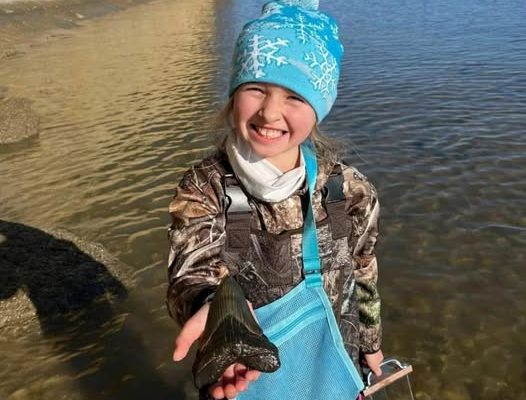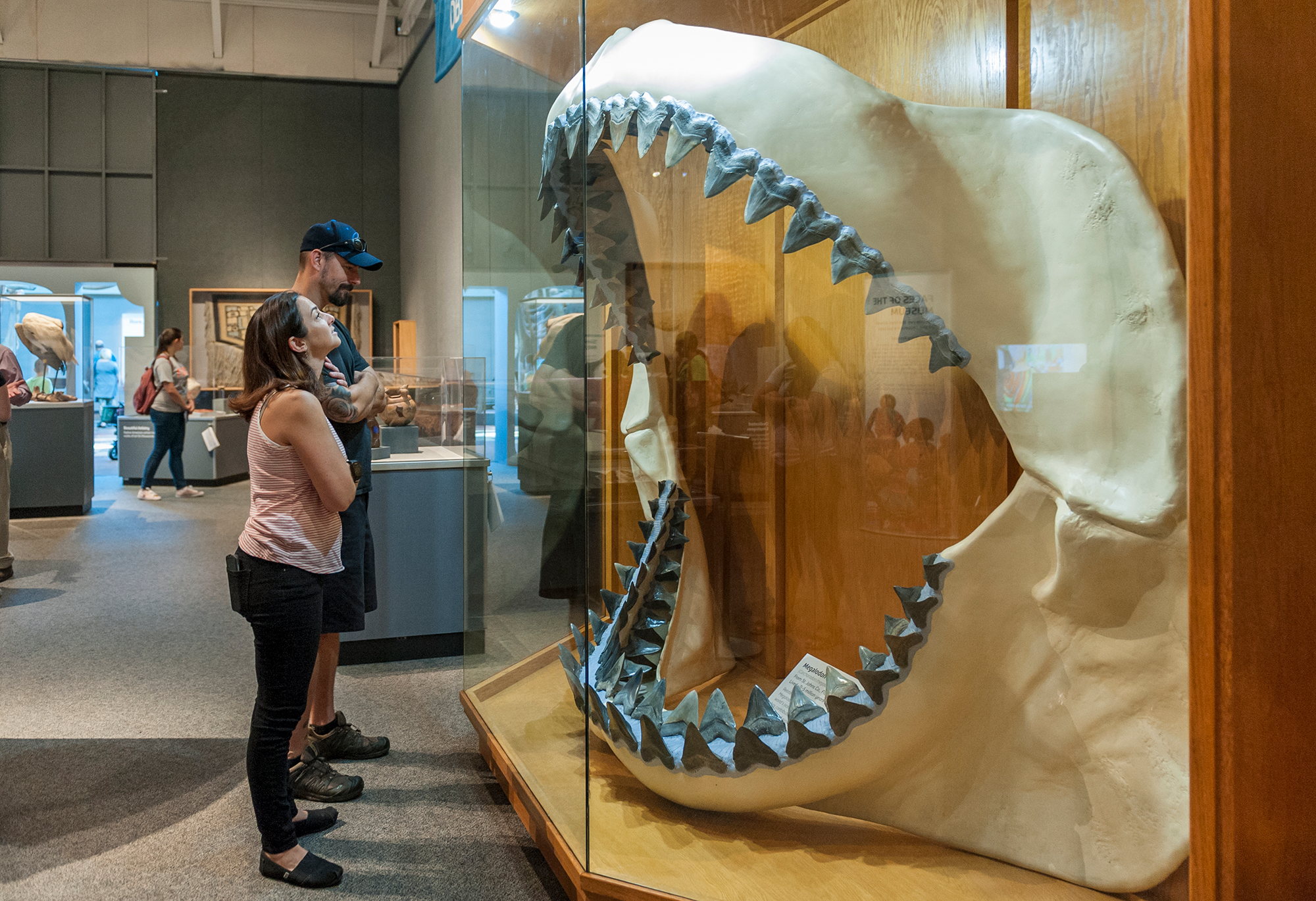
On a chilly Christmas Day in Maryland, most children were unwrapping gifts or enjoying hot cocoa indoors. But for Molly Sampson, a 9-year-old with a passion for prehistoric life, the day turned into a once-in-a-lifetime adventure. What she found beneath the surface of the Chesapeake Bay shoreline is now being hailed as an extraordinary paleontological discovery.
An Ordinary Day Turns Extraordinary
Molly was exploring the sands of Calvert Cliffs State Park, a site along the Chesapeake Bay famous for its fossil deposits. She was equipped with special waterproof boots and a sifting tool—her family knew she had long been fascinated by sharks and marine fossils. Her wish that day? To find a real megalodon tooth.
And incredibly, she did.
Molly pulled from the shore a massive fossil—about 5 inches long, triangular, with sharp serrated edges. It wasn’t just any tooth. It belonged to the Otodus megalodon, an extinct species of giant shark that ruled Earth’s oceans millions of years ago.
What Is a Megalodon?
The megalodon is one of the largest predators in Earth’s history. According to scientists, it lived approximately 23 to 3.6 million years ago and could grow up to 60 feet in length. Its teeth, some of which are over 7 inches long, are among the most iconic fossils from the prehistoric era. These sharks had rows of sharp teeth designed to tear through whales and other large marine animals.
The specimen Molly found is believed to be around 15 million years old, dating it to the Miocene Epoch. Experts confirmed this estimation based on the geology of the Calvert Cliffs Formation, which has been the site of numerous fossil discoveries for decades.

Why Molly’s Find Is So Special
Fossilized shark teeth are not necessarily rare—sharks produce thousands of teeth throughout their lives, and many are preserved over millions of years. But Molly’s find is exceptional for several reasons:
- Size: A 5-inch tooth suggests it came from a megalodon that could have measured more than 45 feet in length.
- Condition: The tooth was remarkably well-preserved, with visible serrations and minimal erosion.
- Location: While Calvert Cliffs is known for shark teeth, large megalodon specimens are not frequently found, especially by children.
According to local paleontologists, this is the type of fossil they might expect to see once every few years, and even then, often in poorer condition.
What Happened Next?
After her discovery, Molly and her family took the tooth to the Calvert Marine Museum, where paleontologists verified its authenticity. The museum houses one of the largest collections of Miocene-era marine fossils on the East Coast and confirmed the tooth’s species and approximate age.
The museum’s staff were not only thrilled about the find but also encouraged Molly to keep exploring her interest in science. Her story has since gone viral, being featured in local and national news outlets.

Is It Valuable?
While Molly’s family has not put a price on the tooth—and likely never will—fossils of this size and quality can fetch several hundred to several thousand dollars, depending on condition, size, and rarity. However, for Molly, the real value lies in the experience and the excitement of discovering something from a world long gone.
Calvert Cliffs: A Paleontological Goldmine
The Calvert Cliffs Formation is a treasure trove of Miocene fossils. Spanning over 24 miles of the western Chesapeake Bay, it contains layers of sediment that have preserved marine life from 10 to 20 million years ago.
Scientists use these sites to study ancient ecosystems, climate changes, and marine biodiversity. Finding well-preserved teeth like Molly’s helps researchers better understand the scale and feeding behavior of extinct predators like megalodon.

How the Megalodon Became a Legend
The megalodon’s name translates to “big tooth,” and for good reason. Fossils like the one Molly found continue to fuel both scientific discovery and pop culture fascination. These massive sharks are often mistaken as ancestors of the great white shark, but research shows they are part of a separate lineage. Otodus megalodon likely evolved from the earlier Otodus obliquus, and not directly from Carcharodon (the great white’s genus), despite similarities in tooth shape.
Fossil evidence suggests that megalodons had an incredibly strong bite force—possibly the most powerful of any known animal. They likely hunted whales, large fish, and sea turtles. Some estimates suggest their bite could exert up to 40,000 pounds of force.
Though they went extinct millions of years ago, megalodons have become cultural icons. They’ve been featured in books, documentaries, and films—most notably “The Meg,” a fictionalized account of a modern-day encounter with a surviving specimen. While entertaining, these stories are firmly in the realm of fiction. No scientific evidence supports the idea that megalodons survived past the Pliocene.
What Causes Fossils Like This to Be Preserved?
Fossilization requires very specific conditions. In the case of megalodon teeth, the key factors are rapid burial and mineral replacement. When a tooth falls to the ocean floor, it must be covered quickly by sediment to protect it from decay and scavengers. Over time, minerals in the surrounding sediment seep into the tooth, replacing organic material and turning it into stone.
This process can take thousands or even millions of years. The coloration of fossil teeth often depends on the minerals present in the sediment—some turn dark gray or black due to iron or manganese, while others may be brown or even bluish.

Inspiring the Next Generation of Scientists
Stories like Molly’s do more than grab headlines—they serve as inspiration for young scientists, particularly girls who are underrepresented in STEM fields. Her excitement, curiosity, and family support are key factors in fostering a lifelong love of science.
Museums, schools, and science centers across the country are using Molly’s story as a case study in education. It demonstrates that science is not just confined to laboratories and classrooms. Real discoveries are possible in backyards, on beaches, and through hands-on exploration.
Paleontologists hope this renewed interest will lead to more funding for field studies, educational outreach, and even local conservation efforts to protect fossil-rich sites like Calvert Cliffs.
Lessons from a Tooth
At first glance, it might seem like just a piece of ancient biology. But a megalodon tooth tells a story: of evolution, extinction, ecology, and Earth’s changing climate. During the Miocene epoch, sea levels were higher and global temperatures warmer, allowing massive predators like the megalodon to thrive.
By studying such fossils, scientists can learn not only about individual species but about entire ecosystems. This data contributes to our understanding of climate change, species migration, and extinction events—critical topics as we face a rapidly changing planet today.
Molly’s fossil isn’t just a museum piece—it’s a clue, a time capsule, and a call to keep exploring.
